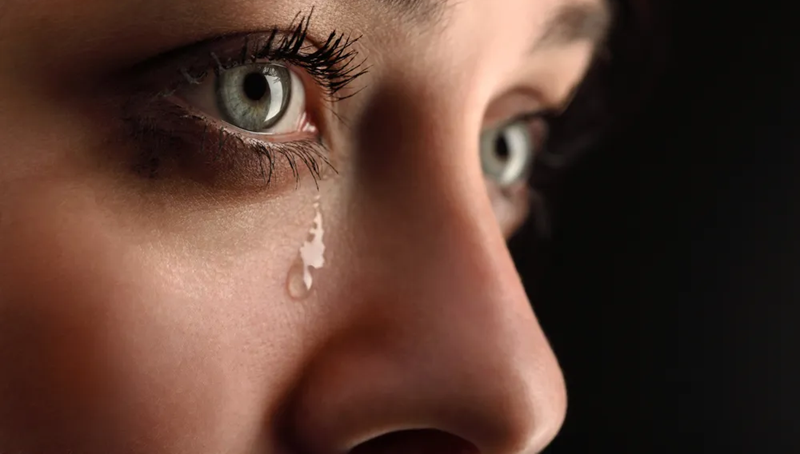Crying as a source of sexual arousal is indeed a controversial and sensitive topic that has garnered attention in psychological and social discussions. While it may seem baffling to some, it is essential to recognize that the human sexuality spectrum is vast and complex, accommodating an array of emotional responses and triggers that can be vastly different for every individual.
For some people, crying can surprisingly act as a catalyst for sexual arousal. This phenomenon could be attributed to various factors, ranging from an empathetic response to a more complex psychosexual aspect known as Dacryphilia.
Dacryphilia is a form of paraphilia where an individual experiences sexual arousal from seeing another person cry or from the act of crying themselves. It is believed that the physical manifestations of crying, such as tears, sobbing, and the vulnerability expressed, can trigger arousal in some individuals. This arousal may not necessarily stem from a place of dominance or desire to inflict pain but could be rooted in empathy or the desire to comfort, which, in a convoluted way, could lead to feelings of arousal.
However, it is crucial to understand that Dacryphilia, like all forms of sexual behavior, should be consensual and respectful. Consent between participating adults is essential to ensure that the act does not venture into the realm of harm, manipulation, or coercion. If crying is induced without the consent of the other party, it can lead to emotional distress and trauma. Therefore, it is vital to maintain open and honest communication between partners about their sexual preferences and boundaries.
From a psychological perspective, crying as a source of sexual arousal might stem from deeper emotional connections and psychological triggers. Crying, as an act, is often associated with vulnerability and emotional release. For some, seeing a partner in such a state may invoke strong feelings of intimacy and closeness, leading to sexual arousal. It’s this raw emotional intimacy that can serve as a powerful catalyst, creating a profound bond between partners.
In conclusion, while crying as a source of sexual arousal might seem unconventional to some, it is a reality for others due to the complexities of human sexuality. It isn’t a universally accepted or widespread phenomenon and may be linked to specific psychological or emotional factors. As with all aspects of human behavior, understanding and empathy are crucial in appreciating the diversity of sexual preferences and experiences.

Understanding the Connection Between Emotions and Desire
Understanding the connection between emotions and desire is a crucial aspect of comprehending human behavior. Emotions are an integral part of our existence, shaping our thoughts, attitudes, and actions. These feelings, whether they are happiness, sadness, anger, or fear, influence our desires, which in turn guide our behavior. Desire, on the other hand, is a strong feeling of wanting to have something or wishing for something to happen. It is fueled by our emotions and can often be a driving force behind our actions and decisions.
For instance, the emotion of love can spark a desire for companionship, while fear can create a desire for safety. Similarly, happiness can lead to a desire for more of the same positive experiences, and sadness can trigger a longing for comfort or change. Therefore, our emotions and desires are interlinked, with each impacting and shaping the other.
It is important to understand that our emotions and desires are not isolated, standalone experiences. They are deeply interwoven, each influencing and being influenced by the other. This intricate relationship is what shapes our motivations, drives our actions, and determines our behavior. Our emotional state can heighten or diminish our desires, and our desires can, in turn, influence our emotional state.
Moreover, understanding the connection between emotions and desire can enable us to better manage our reactions and responses to various situations. By recognizing the emotions that trigger certain desires, we can take steps to control these feelings and thus make more balanced and rational decisions. Additionally, by understanding how our desires influence our emotions, we can learn to manage our expectations and desires in a way that promotes emotional well-being.
In conclusion, the relationship between emotions and desire is complex and multifaceted. By understanding this connection, we can gain greater insight into our behaviors, motivations, and decisions, and use this knowledge to foster emotional balance and well-being.

Psychological Factors Influencing Sexual Arousal and Crying
Psychological factors play a significant role in influencing human emotional responses, such as sexual arousal and crying. The complex interplay of emotional, cognitive, and biological factors can lead to these reactions, creating a spectrum of responses unique to each individual.
For instance, sexual arousal is not solely a physical response but is also significantly influenced by one’s mental state. Stress, anxiety, depression, self-esteem, and various other psychological elements can either enhance or inhibit sexual arousal. Similarly, crying is not merely a reaction to sadness or pain. It is also a complex psychological response that can be prompted by a range of emotional states, from extreme joy to utter despair. Multiple factors such as societal norms, personal beliefs, and past experiences can shape how one expresses emotions through crying.
Both sexual arousal and crying are deeply personal experiences that can be understood better by delving into the intricate web of psychological factors that drive these responses. Furthermore, understanding these factors can help in the development of strategies to manage emotional health effectively and increase overall well-being. For instance, recognizing that high levels of stress or anxiety can dampen sexual arousal may encourage individuals to seek ways to manage these stressors.
Similarly, understanding that crying is a natural, healthy response to a range of emotions can help to dispel societal stigmas associated with this expression, ultimately fostering emotional resilience and well-being. Therefore, the psychological factors influencing sexual arousal and crying are essential to understand and should be considered in the broader context of human emotional health and well-being.
The Role of Vulnerability and Intimacy in Sexual Attraction
The role of vulnerability and intimacy in sexual attraction is profound and multi-faceted. At the core of every deep connection, vulnerability and intimacy serve as the catalyst for elevating the bond beyond superficial attraction. Vulnerability, in the context of sexual attraction, allows individuals to openly express their desires, fears, and expectations.
This openness can heighten the sense of trust between partners, thereby increasing their sexual attraction to each other. Vulnerability can also lead to a deeper understanding and acceptance of each other’s flaws, thereby fostering a more genuine and enduring attraction.
Intimacy, on the other hand, is the bond that gets formed when two people share experiences, thoughts, feelings, and desires. It is not merely a physical act but a deep emotional connection that can greatly amplify sexual attraction. Intimacy involves the willingness to reveal oneself to the other, to let them see you at your most exposed, both physically and emotionally. This act of revealing, of sharing, of opening up, can create a strong sense of closeness and connection, which can significantly enhance sexual attraction.
Both vulnerability and intimacy can make sexual attraction more intense and meaningful. They allow individuals to connect on a deeper level, to understand and appreciate each other’s uniqueness, and to form a bond that goes beyond the physical.
Without vulnerability and intimacy, sexual attraction can be fleeting and shallow. But with them, it can be a powerful, transformative experience that can lead to a deep, fulfilling relationship. Therefore, vulnerability and intimacy play an essential role in sexual attraction, shaping it into a profound connection that can withstand the test of time.
Personal Experiences and Anecdotes: Varied Responses to Crying
Personal experiences and anecdotes often reveal a wide array of responses to the act of crying. Some individuals view tears as a sign of weakness, preferring to keep their emotions closely guarded, projecting an image of stoicism. They deem crying as an unnecessary exhibition of vulnerability and tend to suppress it, even in privacy.
Yet, there are others who interpret crying as a natural, healthy outlet for pent-up feelings and stress. They embrace it as an intrinsic part of human nature and don’t shy away from expressing their emotions openly when overcome by joy, sorrow, or frustration. Quite interestingly, there are those who have a neutral standpoint on crying and treat it as just another human expression, neither encouraging nor discouraging it.
In certain cultures, crying is seen as a symbol of strength and resilience, a testament to enduring pain and adversity. In contrast, there are societies where crying, particularly among men, is frowned upon and considered a taboo. For instance, there are communities where women are expected to cry openly during times of grief, whereas men are expected to remain composed, their tears hidden behind stern expressions. On the other hand, there are cultures where communal crying is seen as a form of bonding, an act that brings people closer together in times of joy or sorrow.
In the realm of personal anecdotes, individuals recount varied responses to crying based on their upbringing, cultural background, and personal beliefs. Some recall being comforted as children when they cried, fostering a sense of security in expressing their emotions.
Others remember being chastised for the same, leading them to associate crying with shame or embarrassment. These varied responses to crying illuminate the vast spectrum of human emotions and the diverse ways in which different people and cultures interpret and respond to them. It is a poignant reminder that our reactions to something as universal as crying can be so remarkably diverse, shaped by a multitude of factors, including societal norms, personal experiences, and cultural influences.

Scientific Perspectives: Research on Emotional Triggers and Sexual Response
Scientific perspectives have increasingly focused on the intricate relationship between emotional triggers and sexual response. This area of research is of paramount importance as it offers insights into the underlying psychological processes that influence sexual behavior.
Emotional triggers, such as stress, anxiety, depression, and happiness, have been found to significantly impact sexual arousal and performance. For instance, positive emotions such as love and happiness could enhance sexual response, while negative emotions like anxiety and depression could inhibit it.
One prominent scientific theory regarding emotional triggers and sexual response is the Dual Control Model. This model suggests that sexual responses are governed by two neurological systems — one that promotes sexual arousal and another that inhibits it. Emotional triggers can influence these systems, thereby affecting sexual response.
For instance, when an individual experiences stress, the inhibitory system may become more active, leading to decreased sexual arousal and performance. Conversely, positive emotional triggers may stimulate the system that promotes sexual arousal, thereby enhancing sexual response.
Research has also explored the impact of emotional intimacy on sexual response. Emotional intimacy, which refers to the closeness and trust between partners, has been found to be a significant predictor of sexual satisfaction. Studies indicate that individuals who report high levels of emotional intimacy with their partners also report higher levels of sexual satisfaction. This suggests that emotional triggers related to intimacy can directly influence sexual response.
In conclusion, scientific research underscores the profound interplay between emotional triggers and sexual response. This research not only contributes to our understanding of human sexuality but also has implications for sexual health education and therapy. It underscores the need for holistic approaches that consider both emotional and physical factors in addressing sexual health issues.
